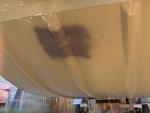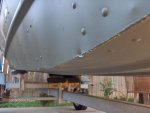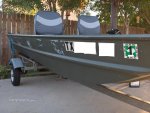Re: Whats wrong with welding?
As a (hobbyist) aluminum welder I can tell you why it's better/easier to repair most aluminum hulls with rivets/patches/JB weld.
Welding works well for attaching aluminum to aluminum provided the following conditions are met:
1) It's the right alloy of aluminum. Some aren't weldable with any strength, some do ok. The only way to tell what your boat is would be metallurgical analysis or finding the alloy name stamped on the boat. Marine aluminum is usually 5052, which is "ok" for welding. 6061 welds better but is more susceptible to corrosion.
2) It's post treated to restore strength. Welded (actually heated) aluminum is weaker than the surrounding metal, and usually harder, hence the cracking. This is NOT tempering like with steel. The process is called "artificial aging". Welded boat makers either use an alloy/thickness that's strong enough without the process or they post-treat the whole boat. You can't do this with a torch, FYI. You need an oven.
3) It's clean. Really clean, like acid etched. TIG welding with AC will push through the Al oxide surface, but you also need to pre-clean and sand the surface carefully, avoiding anything that will embed in the surface. Ideally use an acid bath to pickle the aluminum to make sure it's really clean.
4) You use a compatible/appropriate filler (you need to know the alloy, or use a generic "probably ok" filler
5) You use a heat sink to keep the majority of the aluminum cool. Al conducts heat very well, to the point where if you heat a block of it to near welding temps, the entire block heats to near welding temps. Worse, aluminum doesn't obviously change when heating like steel... it basically looks the same until it reaches its melting temp, then slumps into a pile of slag. You use a heat sink to localize the heat to the weld area.
6) It's a very good idea to pre-heat the weld area to aid the weld. You can do without it, but it makes things much easier.
7) Almost forgot - you have to have a relatively large welder. In order not to melt the entire boat you need to get heat built up fast in a small area. This requires a professional grade welder. My own 200 amp tig can weld aluminum up to about 1/8 inch easily (at the 200 amp setting). More than that and I risk melting everything trying to get it hot enough to weld. Plan on needing a 300 amp or bigger welder for boat work.
It should be obvious that it's not easy to do some of these on a boat... the heat sink and pre-heat in particular (you going to heat the whole boat?) but the killer is usually the cleaning part. If the weld isn't clean you're getting less strength than rivets by far. Cleaning a boat that has been used for a long time outdoors can be really, really hard. You end up grinding away a lot of metal, and the hull may not be thick enough for that.
All that said, it can work. But you have to have the right welding gear, a skilled welder who knows how to weld Al, who knows the proper steps to get a good joint, and you have to have a boat made of an aluminum that is strong enough to not break until the metal naturally re-gains strength (over at least several months up to years).
It's much easier/cheaper to repair it in other ways, especially since the welder could botch the job and melt more holes in the hull.
To repair an aluminum hull you can:
1) Rivet
2) Braze - most people don't want to do this because it looks ugly
3) Interior patch with epoxy/glue
4) High temp solder (with those "aluminum repair rods" you see on TV)
5) Replace the whole hull section and re-rivet at joints/seams.
6) Tighten the rivets and pound out the dents, then patch holes with JB weld or gluvit.
7) Weld
Erik
























